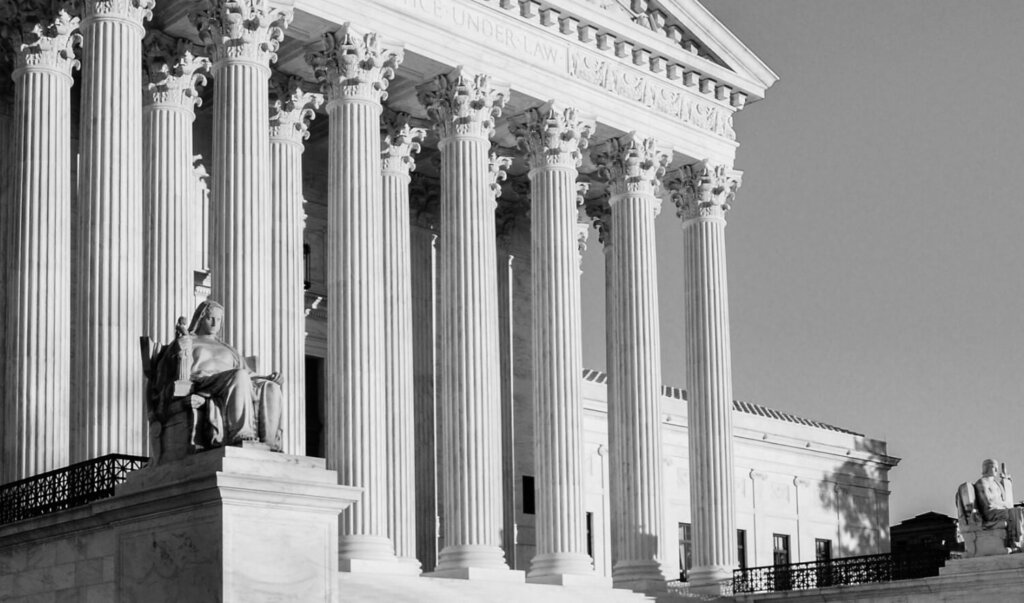Justice Gorsuch delivered the opinion of the court. Justices Ginsburg and Breyer joined him. Justice Sotomayor, Justice Kavanaugh and Justice Thomas filed concurring opinions. Justice Alito dissented, he was joined in his dissenting opinion by Justice Roberts and Justice Kagan.
In the state of Louisiana, in 2016, Evangelisto Ramos was convicted of second degree murder in the 2014 death of Trinece Fedison. Two members of the jury did not believe the state had “proven its case beyond a reasonable doubt.” Despite the lack of unanimity, Ramos was sentenced to life in prison without parole.
If Ramos was tried in any other state (except Oregon), the case would’ve been deemed a mistrial. In the 48 other states, a man accused of a serious crime must be convicted by a unanimous jury.
Background
Why do these states have these laws? “[T]heir origins are clear. Louisiana first endorsed nonunanimous verdicts for serious crimes at a constitutional convention in 1898. … the avowed purpose of that convention was to ‘establish the supremacy of the white race.'”
This convention was held a week after the U.S. Congress began investigating whether Louisiana was intentionally excluding African-Americans from its juries.
“Seeking to avoid unwanted national attention, and aware that this Court would strike down any policy of overt discrimination against African-American jurors as a violation of the Fourteenth Amendment” the convention reviewed demographics and concluded a rule permitting 10-2 verdicts would “ensure the African-American juror service would be meaningless.”
Oregon’s rules permitting 10-2 verdicts can be traced to the rise of the Ku Klux Klan.
“[C]ourts in both Louisiana and Oregon have frankly acknowledged that race was a motivating factor in the adoption of their States’ respective nonunanimity rules.”
The question Ramos put before the Court October 7, 2019, was whether these rules violate the Sixth Amendment right to a jury trial. On April 20, 2020, the Court reversed the appellate court.
Part I
While the Sixth Amendment does not directly state that a “trial by an impartial jury” must be unanimous, Justice Gorsuch stated: “The text and structure of the Constitution clearly suggest that the term … carried with it some meaning about the content and requirements of a jury trial.”
When reviewing what that term meant when the Sixth Amendment was adopted in 1791, “the answer is unmistakable. A jury must reach a unanimous verdict in order to convict.” In fact, unanimous verdicts had been required by that time for around 400 years.
Gorsuch went on to argue that the U.S. Supreme Court has acknowledged the requirement of unanimity. In 1898, in one of the earliest references, the Court stated in Thomas v. Utah, “a defendant enjoys a constitutional right to demand that his liberty should not be taken from him except by the joint action of the court and the unanimous verdict of a jury of twelve persons.”
Part II
In Part II of his opinion, Justice Gorsuch examines how Louisiana and Oregon could still retain these rules despite the clear consensus that a unanimous jury is required for a trial by an impartial jury.
He states that in 1972, two cases put before the U.S. Supreme Court ( Apodaca v. Oregon and Johnson v. Louisiana) allowed for these States’ laws to remain in place despite the dissent of four Justices.
Part III
The State of Louisiana argued that the dissenting Justices in Apodaca as well as any other reference to unanimity came in dicta. Justice Gorsuch states that even to accept Louisiana’s argument, “why would the Court now walk away from many of its own statements about the Constitution’s meaning? And what about the prior 400 years of English and American cases requiring unanimity—should we dismiss those as dicta too?
Louisiana also argues that the revisions made to the language of the Sixth Amendment prior to adoption including the removal of the phrase unanimity means “an intent to abandon common law’s traditional unanimity requirement.”
Justice Gorsuch argues that the “Senators consider the language surplusage … [as] the right to a jury trial meant a trial in which the jury renders a unanimous verdict.”
He also stated that if Louisana were to follow that logic, then they would need to throw out all other concepts the modifications struck from the final language, “i.e., everything history might have taught us about what it means to have a jury trial.”
Louisiana’s remaining argument is that unanimity isn’t a “historic feature of common law jury trials that (we think) serve important enough functions to migrate silently into the Sixth Amendment.”
This is, in fact, the approach the Court took in Apodaca. The Justices in that case argued that the States “have good and important reasons for dispensing with unanimity, such as seeking to reduce the rate of hung juries.”
Justice Gorsuch states: “But who can say whether any particular hung jury is a waste, rather than an example of a jury doing exactly what the plurality said it should— deliberating carefully and safeguarding against overzealous prosecutions?
“As judges, it is not our role to reassess whether the right to a unanimous jury is ‘important enough’ to retain. With humility, we must accept that this right may serve purposes evading our current notice. We are entrusted to preserve and protect that liberty, not balance it away aided by no more than social statistics.”
Part IV
In the fourth part of his opinion, Justice Gorsuch addresses the dissent’s argument that Ramos’ conviction must be affirmed because of the doctrine of stare decisis.
He counters with two arguments. First, even the State of Louisiana admits that Apodaca cannot be viewed as establishing a precedent. Five of the Justices in that case agreed that the Sixth Amendment requires a unanimous verdict to convict.
Second, while the “precedents of this Court warrant our deep respect,” stare decisis has “never been treated as an inexorable command.” Further, Justice Gorsuch argues the Court is charged to look beyond that doctrine when a case is interpreting the Constitution as “a mistaken judicial interpretation of that supreme law is often ‘practically impossible’ to correct through other means.”
When reviewing a precedent of the U.S. Supreme Court, the Justices have “traditionally considered the quality of the decision’s reasoning; its consistency with related decisions; legal developments since the decision; and reliance on the decision.”
“In the final accounting, the dissent’s stare decisis arguments round to zero. We have an admittedly mistaken decision, on a constitutional issue, an outlier on the day it was decided, one that’s become lonelier with time.
Part V
In conclusion, Justice Gorsuch stated: “In the end, the best anyone can seem to muster against Mr. Ramos is that, if we dared to admit in his case what we all know to be true about the Sixth Amendment, we might have to say the same in some others. But where is the justice in that? Every judge must learn to live with the fact he or she will make some mistakes; it comes with the territory. But it is something else entirely to perpetuate something we all know to be wrong only because we fear the consequences of being right. The judgment of the Court of Appeals is Reversed.”
Read the full opinions for Ramos v. Louisiana here.









